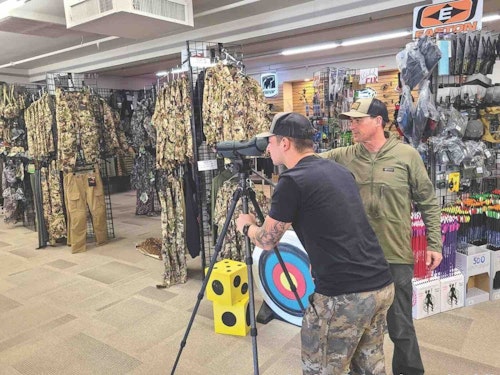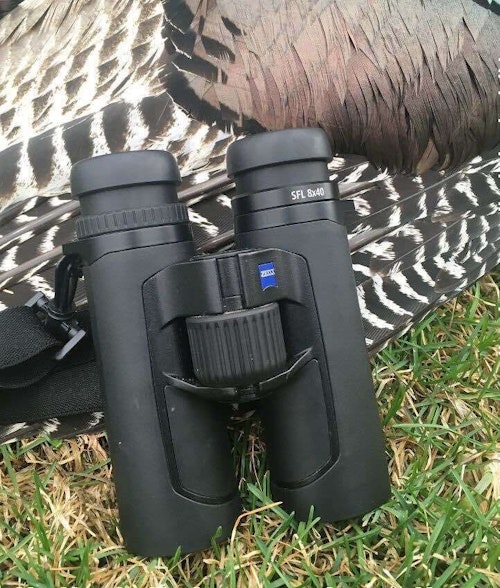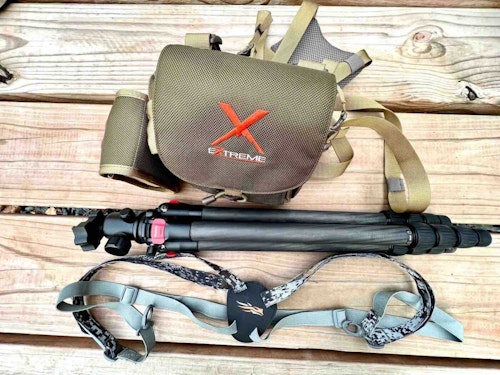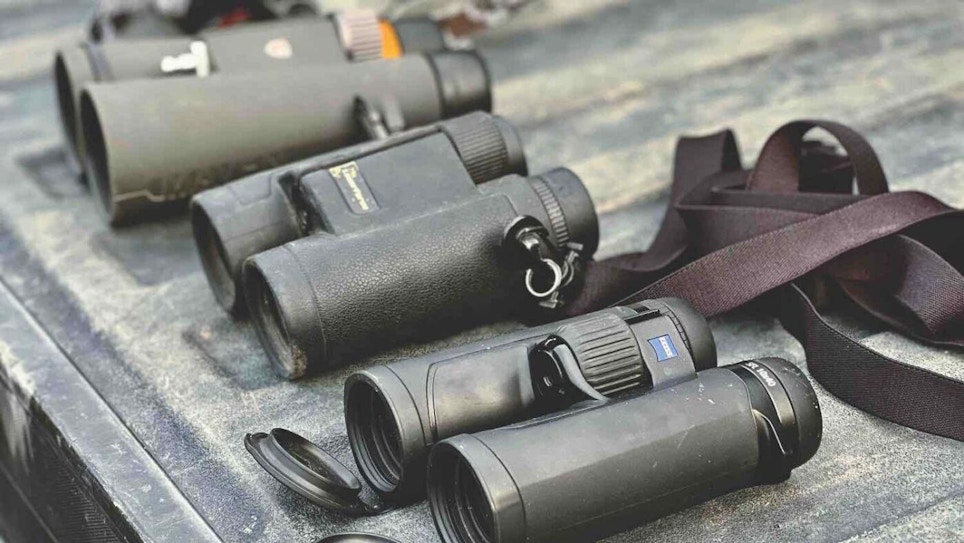It’s risky to offer something that you haven’t previously, or to give another go at something you’ve already failed with in the past. But guess what, most things in life and business worth achieving begin with taking smart risks. Welcome to the world of bowhunting optics.
Taking on optics is definitely risky for small archery dealers — let’s not sweep that under the rug. Why is it risky? Well, an archery store isn’t typically the first place consumers think of when they want to buy a rangefinder, binocular or spotting scope. Instead, most envision a trip to the glass case inside a large sporting goods store where the selection is broad. But, that doesn’t mean you should give the big stores the entire pie. You can have your sliver, too.
Optic needs differ based on geographic location, so what sells well in Casper, Wyoming, for example, might collect dust in Asheville, North Carolina. In other words, there isn’t a one-size-fits-all product selection that works for every archery shop. That’s why I chatted optics with Al Kraus of Black Hills Archery in Rapid City, South Dakota, before writing this article. His store is located near prime whitetail hunting, yet is also within close proximity of western species such as elk and pronghorn. Not only is Kraus a driven hunter and longtime retailer, but he knows the archery industry extremely well, too.
I believe most archery dealers can benefit by offering optics at some level. So, if you aren’t currently offering optics, consider giving it a go. But first, let the following principles guide you as you begin.

Getting Started and Mistakes to Avoid
Kraus, who’s been offering optics at Black Hills Archery for about 20 years, said there’s a learning curve with getting started.
“When I first brought in optics, which was around the time I acquired the store, I brought in too many different options,” he began. “With binoculars, for example, I brought in compacts, 10x, 12x and so on. All I seemed to sell consistently was what I personally carried while hunting. It was extremely difficult to sell anything else. A year or two after bringing in all of those different optics, I was left with lots of inventory that I couldn’t sell because I couldn’t exactly recommend it.
“I’ve bowhunted my entire life — that’s truly the only way that I hunt. I know what works, so I transitioned to selling only what I trust in, have experience with and use myself. Once people get to know you, understand your experience and begin to trust your reputation, nine times out of ten, they’ll buy what you use. Most will prompt you to ‘Tell me what to get.’”
Of course, Kraus said that field-testing was an important part of determining what works and ultimately what he could sell with confidence. And his optic sales have been guided by the sell-what-I-use principle ever since with solid results.
Stock a Smart Selection
As with most product categories, many optic manufacturers produce high-quality products. This makes it challenging to land on a manageable selection. Kraus offered some suggestions.
“In my store, I carry just two lines,” he said. “I do this so that I can cover the intermediate and driven customers. The guys who need optics but don’t have a lot to spend are shown Hawke optics. I believe that Hawke is the best for the money. The optics are well-built, the glass and components are good, and the warranty is good. And for the very serious hunters, I offer Swarovski, which is what I use and believe to be the best out there.”
Besides lines, another decision archery dealers must navigate is which products within the optics category to offer. Kraus doesn’t cross into the riflescope territory; he focuses only on products that relate to bowhunters.
“We offer binoculars, rangefinders and spotting scopes,” he explained. “I keep all of those products in stock from both brands. You don’t want to be buried with inventory, but you can’t sell it if you don’t have it. The last thing customers want to hear you say is, ‘I don’t have it, but I can order it.’ If you have it in stock and they ask for it, your chances of selling are far better.”

Foster a Pro Shop Vibe
Earlier, I discussed the importance of offering only optics that you use and believe in. I haven’t met any retailers who themselves use cheap optics. Successful bowhunters with decades of experience are generally very particular with what they use, and that often means using one of the best out there. You’re a pro, and you run a pro shop. Selling cheap optics will cheapen your pro shop’s vibe and atmosphere, so don’t stoop in product quality.
“Again, I made the mistake in the beginning of trying to sell cheaper stuff, “Kraus said. “It always seems to backfire. I don’t skimp any more. I try to do the best and offer my customers the best. A brand like Swarovski truly aligns with the ‘pro’ atmosphere of Black Hills Archery.”
What Are the Risks?
Now that I’ve discussed tips for getting into the optics category, it’s time to ask this question: What are the risks, and are they worth the rewards?
“You’ll always have the large retailers breathing down on you,” Kraus said. “But, competition is reality. Another thing with stocking high-end optics is that you tie up a lot of money in order to stock the shelves. There’s no way around that. You don’t need to have a dozen expensive binoculars in stock at a time, but you’d better have a few if you want to sell any. Investing into slow-moving inventory is a risk that you have to accept when offering optics.”
Pricing and Sales Tips
With optics being a highly competitive category that most large stores dominate, Kraus suggests holding your ground and being as competitive as possible.
“I MAP (minimum advertised pricing) everything,” he said, “because I have to compete with the larger retailers. Most retailers big and small go with MAP pricing. Customers often misconceive that box stores will be cheaper just because they’re bigger. However, if folks take the time to carefully compare product pricing, they’ll often find that smaller retailers like me do what we can to be there for our customers and match big-retailer pricing.”
There’s a lot of value to the customer in buying from an expert at a pro shop. When they purchase optics — or anything, for that matter — they get the peace of mind that they can walk in and talk with an expert at any time. While the optics counter of a large sporting goods store might be run by an expert, it often isn’t. So, even if a binocular is a little less expensive at a large retail store, it’s possible that the sales associate behind the counter is less experienced. So, be an expert; that’s your edge.
It’s truer with optics than most other product categories: Seeing is believing. Like Kraus said earlier, customers won’t likely commit to buying something they cannot see and touch.
“Again, you must have it in order to sell it,” he said. “Customers don’t want to special order optics. They want to hold a binocular and look through it. They want to look through a spotting scope on a tripod and get a feel for what they’re buying before they commit.”
There’s no denying that top-notch optics are expensive. Obviously, that’ll be an objection for some customers. As the expert, Kraus said you must convey to your customer that he or she is getting a good exchange for their money.
“I sell numerous binoculars and spotting scopes off a tailgate in my parking lot,” Kraus said. “It’s one thing for the customer to handle optics in the store and look through the window with them. But the seeing-is-believing adage takes on a whole new meaning when customers use their current optic next to a brand new Swarovski optic right before dark in my parking lot. When they can have both optics side by side and look at a sign 1 mile away, they see that the Swarovski is just so much brighter in that low-light context. Swarovski’s light transmission is superior.”
Kraus said his sales associates aren’t incentivized with commissions because he wants his customers to feel a pressure-free buying experience.
“We’ve never done commission sales and never will,” he explained. “I don’t believe in commission sales because an associate in that role tends to try to sell the customer the most expensive item. I don’t like the pressure it adds. I want my customers to know that we’re here to help them with the money that they have to spend. We don’t try to elongate their budgets.”

Tap Into It!
Kraus licked the seal on our optics discussion with some parting wisdom for dealers exploring the prospect of offering optics for the first time.
“Learn from the mistakes that I made in my early days,” he said. “Don’t try to offer everything. Just specialize in your field. Sell what you use and believe in. That way, when people ask for your suggestion, you can sell them a product confidently because you already know that it works.
“One other thing to consider is location. We’re in South Dakota where the terrain is pretty open. Swarovski 10x42s are the bestselling binoculars here and have been for nearly 20 years. Shops in the East, though, will want to offer binoculars with less magnification given the reduced visibility in the timber. Also, spotting scopes will be more difficult to sell in the East than out here. You must offer what will truly be useful in your area in order to sell it.”
To finish, I acknowledge that the optics category is risky for a small archery retailer to take on. But, when you let the principles discussed herein guide you, it becomes a smart risk that can lead to some worthwhile sales.
Sidebar: Are Optic Accessories Worth It?
While you don’t want to wade too deep into the optics category, it’s not a bad idea to offer a few simple accessories. If your shop is located where long-distance glassing is common, then having a couple of tripods on hand gives you the option for add-on sales to customers who are already purchasing spotting scopes. Likewise, a binocular pouch/harness with a side pocket for a rangefinder is popular out West.

Regardless of your location, simplistic binocular harnesses are easy to add onto nearly every binocular you sell. Explain to the customer how uncomfortable a standard neck strap (included with a binocular) is, and then let them test a binocular on a harness strap. There’s no comparison, and most will buy the harness with their binocular purchase. (FYI: The bino harness shown in the photo above is from ALPS OutdoorZ.)






